 |
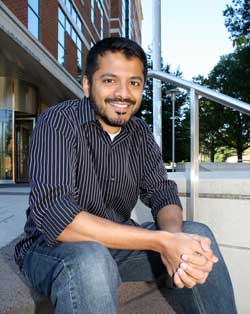
|
|
Kedar Narayan, Immunologist, National Cancer Institute (NCI), National Institutes of Health (NIH)
|
1. I chose this career because...
2. My typical workday involves...
3. What I like best/least about my work...
4. My career goals are...
5. When I'm not working, I like to...
|
|
1. I chose this career because...
|
Back to Top

|
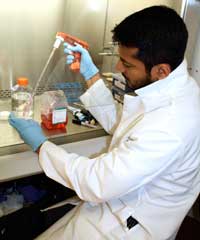
|
|
Kedar prepares donor cells for exposure to HIV in a study on the mechanisms of viral transmission.
|
I chose to become an immunologist because the specialty was a natural evolution of my interests in science. I never took biology in high school. When I was young, the thing I was sure I did not want to do was biology. At the time, I was interested in architecture. In high school, I had a great chemistry teacher. She actually didn’t like me at all because I was always playing around in the lab. But I loved the subject, and chose to pursue it in college.
When I was in college, I had to do a project on binding kinetics. I chose to study antibodies as a model. That project got me interested in immunology. I started checking books out of the library and studying and reading on my own. The more I read, the more I wanted to learn about how our bodies fight infection. It was then that I realized I had no background in biology; so I decided to do a second degree. Slowly I began to transition into the natural sciences and started taking subjects like biochemistry, molecular biology, and pathology.
I continued my education in immunology and decided to come to the United States (US) to earn my doctorate degree. A doctor of philosophy degree (or Ph.D.) in the British education system starts with bench work. The US system begins with 1 year of formal studies before starting bench work. I felt I needed more of the classroom aspect in immunology before I started my research.
Education
- Doctor of Philosophy, Immunology, Johns Hopkins School of Medicine, Baltimore, Maryland
- Bachelor of Arts, Natural Sciences, University of Cambridge, United Kingdom
- Bachelor of Science, Chemistry, Loyola College, India
|
|
2. My typical workday involves...
|
Back to Top

|
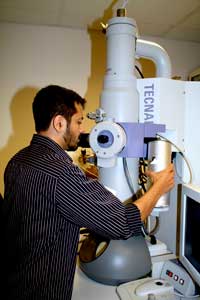
|
|
Kedar uses the transmission electron microscope (as shown) to take high resolution images of cells.
|
My typical workday involves the tasks I perform to uncover the mysteries of human immunodeficiency virus (or HIV) transmission.
My Lab
From the study of immunology at Hopkins, I transitioned to the study of HIV biology at the NIH. My lab at the NIH is very interesting because my colleagues and I come from diverse educational backgrounds. We have mathematicians, programmers, engineers and microscopists. My lab is developing new and sophisticated imaging technologies to study HIV. I use this technology in my research.
My Research
Using advanced imaging techniques to study HIV transmission
HIV is the agent that causes acquired immune deficiency syndrome (commonly known as AIDS). Scientists know that HIV spreads by sexual transmission, but the exact details of transmission are still unclear. One of the important questions is, “What are the precise mechanisms of HIV transmission from one cell to another?” We have developed 3-dimensional (3D) imaging techniques that allow us to visualize this transmission at high resolution. We can create still images, and also movies of HIV as the viruses move between cells, across cell membranes, and within a single cell. These images and videos, once captured, can be further analyzed with specialized computer software programs.
Recently we published a paper on HIV transmission in an internationally recognized science publication, and an artist’s rendition of one of our lab’s 3D images was published on the cover. (See issue, Proceedings of the National Academy of Sciences of the United States of America July 27, 2010, volume 107, number 30, pages 13336-13341.)
My lab tasks are to:
- get cells from donors and differentiate them appropriately
- add fluorescent HIV to these cells in vitro (the fluorescence enables us to visualize the virus moving around the cell in real time)
- use a light microscope to watch the virus move around the cells and record movies
- process cells and use a specialized electron microscope to image the location of these viruses within these cells
- use specialized software programs that can pull together a series of 2D images to make a 3D volume of these cells with the viruses “caught in the act” of being transferred from one cell to another
|
|
3. What I like best/least about my work...
|
Back to Top

|
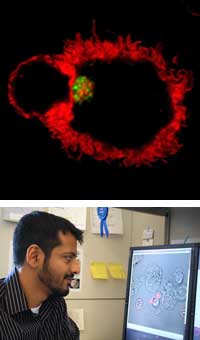
|
|
The green fluorescent-labeled HIV is being processed by two cells of the immune system (top). Kedar uses special software programs to analyze images captured by a microscope (bottom).
|
What I like the best and least about my work is almost the same. What is best is that you don’t have a mundane 9 to 5 job to do each day. But that is also what makes it bad in some ways. Life can get very unstructured. Sometimes there is a lot of waiting involved. Other times, it is difficult to leave your work and go home. For example, I have had stretches where I had to work 14 plus hours every day for many days straight. That leaves no time to do little things like grocery shopping or getting a haircut. Similarly, the competition from other labs can be a great motivator, but can be physically and mentally draining as well. But the drive to find the answers to our research questions is what makes my work so much fun.
|
|
4. My career goals are...
|
Back to Top

|
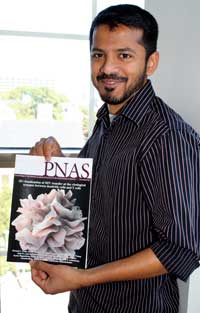
|
|
Kedar holds a copy of PNAS, on which the cover depicts an arist’s rendition of a 3D image created in his lab.
|
My current goal is to find out the exact mechanism by which HIV is transmitted from cell to cell after sexual contact. If we can do this, then we may be able to create an effective vaccine or therapeutic intervention. Eventually, I want to use these imaging technologies to investigate transmission of other infectious agents as well.
|
|
5. When I'm not working, I like to...
|
Back to Top

|
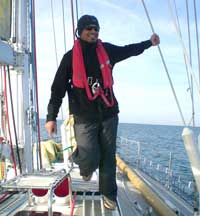
|
|
Kedar balances himself on deck, as he sails around the Isle of Wight in England.
|
When I’m not working, I enjoy many outdoor activities such as hiking and cycling. I am currently trying to sail competently. I also do yoga every day. I really enjoy eating a variety of good foods. There is literally no cuisine that I don’t like. I call myself a vegetarian, but I admit I cheat every once in a while. I have travelled quite a bit, and I still try to grab my backpack and head out whenever possible.
|
|
|
|
 |